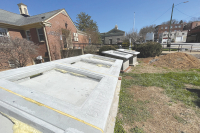Jackson County seeks input on draft comprehensive plan

As the saying goes, change is life’s only constant — so Jackson County is looking for input to guide its approach to the changes that the next 25 years are likely to bring.
For the past two years, a steering committee made up of leaders from sectors spanning government, education, health, business and transportation has been working to hammer out a consensus on what the county’s future needs might be and how to meet them as they transpire. Now, a draft comprehensive plan is days away from being published and the Jackson County Planning Department is hosting a round of public meetings to get input on the document.
“I hope we get a lot of feedback,” said County Planner Michael Poston. “Positive or negative, at least it gives us an idea of how we put together this plan. This isn’t a stopping point. It’s not like we have this plan in draft form and we’re not going to make any changes to it. We want to take into account all those different comments that we get and see how it could make the plan better and more reflective of the community.”
The wide-ranging plan addresses everything from encouraging multi-modal transportation and increasing recreational opportunities to promoting community planning and increasing housing opportunities. It includes broad goals as well as specific objectives for a wide range of issues and breaks down the objectives into more than 200 “action items,” each of which is coded as either a short-term, mid-term, long-term or ongoing endeavor. Generally speaking, Poston said, a short-term project might be completed within three years, while a mid-term project would take four to 10 years and a long-term project would take more than 10 years.
“It’s not a sprint,” Poston said. “This isn’t something that’s all going to happen like that. It takes time.”
But agreeing on the goals and starting discussions as to how to attain them is a pivotal component of growing the county in a positive direction, Poston said.
Related Items
Smorgasbord of topics
Many topics are covered in the plan, and it’s difficult to predict which of them might provoke the most discussion, whether positive or negative.
“I think that’s going to depend on who happens to show up on a given night,” said Ron Mau, who represents the Village of Forest Hills on the steering committee and will take office as a Jackson County commissioner in December. “I think the big thing now is to get people to show up to these meetings.”
Poston expects that aspects of the plan dealing with land development might garner some comment, simply because land use regulations typically do generate concern among mountain residents. For the most part, however, he said the regulations being proposed in the plan would apply only to major subdivisions, not smaller projects such as parents wanting to subdivide their property to deed to their children.
However, land use will need to be a continuing topic of discussion as the county develops, Poston said. Jackson County has a limited supply of buildable land, with most of the land that’s suitable for construction falling within existing towns and communities.
“I think what that really leads to is we want to be really thoughtful in how we approach growth and development,” Poston said. “I think a lot of what we recommend in there (the plan) really looks at how we grow in areas that will have existing infrastructure and how we maintain that infrastructure.”
Infrastructure has a bigger influence on development in the mountains than in flatter areas, because the topography doesn’t allow those systems to be ubiquitous.
“Water and sewer, that’s the big driver,” Mau said. “Where does it already exist and how can we encourage development in those areas?”
The plan recommends that small area plans be completed for unincorporated communities like Cullowhee, Cashiers and the U.S. 441 corridor. These plans would follow a process similar to the comprehensive plan but focus on those particular communities rather than on the county as a whole, creating a vision for the community’s future.
“You create a document that says what the community wants to be when it grows up,” Poston explained.
Housing is another pivotal issue that the draft plan explores. It’s hard for working families in Jackson County to find quality housing that’s accessible to their income level, Poston said, and that can result in economic loss to the county.
“What we hear anecdotally from the university and from the hospital is we see a lot of folks living in other counties that commute into Jackson County because they’re not finding a whole lot in that workforce type of housing market,” Poston said.
Developing policies that encourage high-density housing — like condos and apartments — and ensuring that the infrastructure is in place to support that type of housing are two potential solutions mentioned in the draft plan. Policies to promote the maintenance of existing homes could also help, as could continued partnerships with assistance-providing organizations like Mountain Projects.
Broadband internet is another issue the plan addresses, and it goes hand-in-hand with housing.
“What do you do to buy a new home? You take out your phone and you’re looking — do I have a signal?” Poston said.
If potential residents can’t get internet at the property they’re investigating, they’re less likely to move in. Broadband availability is an issue across the mountains, with rugged topography and sparse populations making it difficult to deliver the service to the region’s remote hills and hollers.
Approaches outlined in the plan include encouraging open communication between various types of utility providers through formation of a utility consortium, which could lead to opportunities such as co-location and private partnerships. An inventory of existing resources should be completed, the plan says, along with exploration of funding options and a point person to pursue them. The plan outlines some specific partnerships that should be explored and suggests that wireless hot spots be created at locations such as fire stations, community centers and recreation centers.
Transportation planning also figures heavily into the plan, though a separate plan is currently being completed — guided by the same steering committee — to address transportation specifically.
Alternative transportation is a big push in the draft plan. There’s a good reason for that, Poston said, and it has to do with Jackson County’s lack of accessible routes for road construction. Topography makes it expensive, if not impossible, to build new roads, so existing arteries have to handle the always-increasing number of cars on the road. For instance, N.C. 107 from Sylva to Cullowhee is currently in line for an improvement project that will markedly increase its traffic handling capacity, but by the time the 25 years covered by the new comprehensive plan is over, even expanded capacity may not be enough.
“Even calculating that improvement and what it would do to increase capacity, by 2040 — which is our target year — we’re actually nearing capacity on 107,” Poston said. “There’s not a lot of options to where you go from there. You can’t just go 100 feet over and build a new road. Multi-modal transportation becomes a conversation that can help with that.”
Multi-modal transportation could mean bike paths, walking trails and sidewalks. Expansion of local and regional transit options could also play a role.
Infrastructure aimed at multi-modal transportation would be focused in places where populations are already concentrated, Poston said. For instance, Dillsboro, Sylva and Webster are already closely connected, so providing walking and biking routes between the three communities would make sense — much more sense than building sidewalks throughout Caney Fork, for instance.
“Not that it’s ever going to be Asheville or a big city,” Poston said, “but I think you can incorporate some of those concepts into how you grow to accommodate some of the growth we see coming.”
A moving target
Of course, another aspect of the plan will have to be flexibility. A county can anticipate the future, but it can never foresee it.
For instance, Poston said, Jackson County’s last comprehensive plan was completed in the early 2000s. Then, “2008 happened and every plan that was made before that — you can’t predict something like that. That changed everything.”
But having some sense of direction is pivotal to making important advancements come to pass, even if those goals are attained years or even decades later than originally anticipated. The first comprehensive plan developed in Jackson County came about in 1974, and when Poston dug it up he discovered that many of the goals contained there didn’t come to pass until much later.
For instance, the plan called for creation of a water and sewer authority, adoption of subdivision standards, a sedimentation control ordinance and zoning in strategic areas. The Tuckaseigee Water and Sewer Authority didn’t come into being until 1992, a sedimentation control ordinance was adopted in 2000, Cashiers became the county’s first zoning district in 2003 and subdivision standards weren’t adopted until 2007.
“It takes time, but if you don’t start planning for it in 1974, by the time the ordinance came in 2004 you hadn’t talked about it,” Poston said.
Be heard
A series of community meetings has been scheduled to take input on the draft Jackson County comprehensive plan, which outlines goals for the next two decades covering everything from education to infrastructure. All meetings will be drop-in sessions running from 5 to 7 p.m.
The Jackson County Planning Department is in the process of formatting the draft document and will post it at www.jacksonnc.org/planning.html prior to the first meeting.
• Tuesday, Nov. 29, at the Jackson County Department on Aging on 100 County Services Park, Sylva.
• Monday, Dec. 5, at the Tuckasegee VFW on 26 Canada Road, Tuckasegee.
• Tuesday, Dec. 6, at the Qualla Community Building on 180 Shoal Creek Church Loop, Whittier.
• Monday, Dec. 12, at the Cashiers Library on 249 Frank Allen Road, Cashiers.
• Tuesday, Dec. 13, at the Savannah Community Building on 611 East Fork Road, Sylva.









